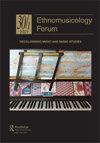Loss of place, loss of self: musical heterotopias in Franco’s prisons (1938–1945)
IF 0.5
1区 艺术学
0 MUSIC
引用次数: 0
Abstract
ABSTRACTAt the end of the Spanish Civil War, the Fascist Government led by General Franco implemented a regime of extensive suppression over the population. As a result, prisons became overcrowded with thousands of political opponents. From 1938—a year before the end of the armed conflict—to 1943, musical practices were considered a crucial component of the propaganda programmes implemented in prisons to control and re-educate the inmates. In response to this official sonic environment, prisoners also cultivated their own musical practices as a means of preserving their self-identities. The initial section of the article offers a brief overview of the living conditions experienced in Spanish prisons during Franco’s regime. In the subsequent part, I delve into the significance of the unofficial musical practices developed by detainees, examining their relationship to concepts such as space, place, heterotopia, and the ‘construction of the self’. Due to the state’s ability to exert epistemic violence by suppressing individuals and groups’ capacity to speak or be heard, these unofficial musical practices can be regarded as cultural artefacts that emerged as a means of resistance against the propaganda enforced by the Franco government.KEYWORDS: Francoismpolitical prisonersprisonssonic environmentheterotopiaidentity AcknowledgementsI would like to express my very great appreciation to Gemma Pérez Zalduondo as my main thesis supervisor, whose expertise and advice in the area has been very valuable to me. Advice given by Professors Erik Levi and Julie Brown during my studies at the Music Department of Royal Holloway, University of London have been a great help in encouraging me to publish in an English journal. I wish to acknowledge the help provided by my British colleagues with the translation of the article. I would like to thank the following institutions for their assistance with the collection of my data: Spanish National Library, Library and Archive of the Spanish General Direction of Prisons, Archive of the Spanish Communist Party, British National Library, British National Archives, Marx Memorial Museum and Worker’s Library and The People’s History Museum of Manchester.My special thanks are extended to the interviewees for sharing their experiences with me: Marcos Ana, José Ajenjo Bielsa, Teresa Bielsa Martínez, Luis Pérez Lara, José Espinosa, and Eduardo Rincón.Disclosure statementNo potential conflict of interest was reported by the author(s).Data availability statementThe data that support the findings of this study are available on request from the author. The data are not publicly available because they contain information that could compromise the privacy of research participants.Notes1 All translations from Spanish sources are mine.2 The numbers associated with political repression in Spain during Francoism is a critical point as the Spanish Government has never published any official information, so the up-to-date information comes from different researchers from the 1980s onwards. For example, Hugh Thomas estimates that 100,000 people were killed by the Francoists during the Civil War (Citation1961: 209–71). Another historian, Michael Richards argues that taking into account people who were killed during the war and those who died in prison, the number of deaths increases to 400,000 (1998: 11). Among those, according to Guy Hermet, 192,000 would correspond to prisoners executed under martial law (Citation1984: 10). On the other hand, the Report of the Working Group on Enforced or Involuntary Disappearances of the United Nations (Citation2014) gives the number 114,000 for those kidnapped by the dictatorship. Among those, 30,000 would be children of jailed mothers, taken while their mothers were imprisoned.Additional informationFundingThis work was supported by the Spanish Postdoctoral Fellowship Programme Juan de la Cierva from the Ministerio de Ciencia e Innovación (Ministry of Scientific Innovation) [FJC2021-046775-I] and the European Union Next Generation and the Agencia Estatal de Investigación (Spanish National Investigation Agency).Notes on contributorsElsa Calero-CarramolinoElsa Calero-Carramolino is a musicologist of the University Autónoma of Madrid (2014) and holds an MRes Musical Heritage from the International University of Andalusia (2015). In October 2021 she defended her doctoral thesis obtaining the cum laude qualification with international mention. She is currently a postdoctoral fellow at the Music and Art Department of the University Autónoma of Barcelona, where she is developing research about the presence of music in execution trials. Her research interests are music as punishment, repression, and as a torture and subversion device during the processes of forced detention in Francoist Spain (1938–1978).失去位置,失去自我:佛朗哥监狱中的音乐异托邦(1938-1945)
【摘要】西班牙内战结束后,以佛朗哥将军为首的法西斯政府对民众实行了广泛的镇压。结果,监狱里挤满了成千上万的政治反对派。从1938年(武装冲突结束前一年)到1943年,音乐实践被认为是监狱宣传计划的重要组成部分,目的是控制和再教育囚犯。为了回应这种官方的声音环境,囚犯们也培养了自己的音乐实践,作为保持自我身份的一种手段。文章的开头部分简要概述了佛朗哥统治时期西班牙监狱的生活条件。在接下来的部分中,我深入研究了被拘留者发展的非官方音乐实践的意义,研究了他们与空间、地点、异托邦和“自我构建”等概念的关系。由于国家有能力通过压制个人和团体说话或被倾听的能力来施加认知暴力,这些非官方的音乐实践可以被视为文化文物,作为抵抗佛朗哥政府强制宣传的一种手段。我非常感谢杰玛·帕萨雷兹·扎尔多作为我的主要论文导师,她在这方面的专业知识和建议对我来说非常宝贵。在伦敦大学皇家霍洛威学院音乐系学习期间,Erik Levi教授和Julie Brown教授给我的建议对我在英文期刊上发表论文有很大的帮助。我要感谢我的英国同事在翻译这篇文章时所提供的帮助。我要感谢以下机构协助收集我的数据:西班牙国家图书馆、西班牙监狱总方向图书馆和档案馆、西班牙共产党档案馆、英国国家图书馆、英国国家档案馆、马克思纪念博物馆和工人图书馆以及曼彻斯特人民历史博物馆。我要特别感谢受访者与我分享他们的经历:马科斯·安娜、约瑟·阿金乔·贝尔萨、特蕾莎·贝尔萨Martínez、路易斯·帕姆雷斯·劳拉、约瑟·埃斯皮诺萨和爱德华多Rincón。披露声明作者未报告潜在的利益冲突。数据可用性声明支持本研究结果的数据可应作者要求提供。这些数据没有公开,因为它们包含的信息可能会损害研究参与者的隐私。注1所有来自西班牙语的翻译都是我的与佛朗哥统治时期西班牙政治镇压相关的数据是一个关键点,因为西班牙政府从未发布过任何官方信息,所以最新的信息来自于20世纪80年代以来不同的研究人员。例如,休·托马斯估计在内战期间有10万人被弗朗哥主义者杀害(Citation1961: 209-71)。另一位历史学家迈克尔·理查兹认为,如果把在战争中被杀害的人和死于监狱的人计算在内,死亡人数将增加到40万人(1998:11)。根据Guy Hermet的说法,其中19.2万是根据戒严法处决的囚犯(Citation1984: 10)。另一方面,联合国强迫或非自愿失踪问题工作组的报告(Citation2014)给出了被独裁政权绑架的人数为114,000人。其中3万人是母亲入狱的孩子,是在母亲入狱期间被带走的。本研究得到了西班牙科学创新部(Ministerio de Ciencia e Innovación) [FJC2021-046775-I]、欧盟下一代和西班牙国家调查局(Agencia Estatal de Investigación) Juan de la Cierva博士后奖学金计划的支持。elsa Calero-Carramolino是马德里大学Autónoma的音乐学家(2014年),并持有安达卢西亚国际大学的MRes音乐遗产(2015年)。2021年10月,她为自己的博士论文辩护,获得了国际提及的优等生资格。她目前是巴塞罗那大学Autónoma音乐与艺术系的博士后,在那里她正在开展关于音乐在死刑审判中的存在的研究。她的研究兴趣是在佛朗哥统治下的西班牙(1938-1978)强制拘留过程中,音乐作为惩罚、镇压、折磨和颠覆的工具。
本文章由计算机程序翻译,如有差异,请以英文原文为准。
求助全文
约1分钟内获得全文
求助全文
来源期刊

Ethnomusicology Forum
MUSIC-
CiteScore
1.10
自引率
25.00%
发文量
29
期刊介绍:
Articles often emphasise first-hand, sustained engagement with people as music makers, taking the form of ethnographic writing following one or more periods of fieldwork. Typically, ethnographies aim for a broad assessment of the processes and contexts through and within which music is imagined, discussed and made. Ethnography may be synthesised with a variety of analytical, historical and other methodologies, often entering into dialogue with other disciplinary areas such as music psychology, music education, historical musicology, performance studies, critical theory, dance, folklore and linguistics. The field is therefore characterised by its breadth in theory and method, its interdisciplinary nature and its global perspective.
 求助内容:
求助内容: 应助结果提醒方式:
应助结果提醒方式:


